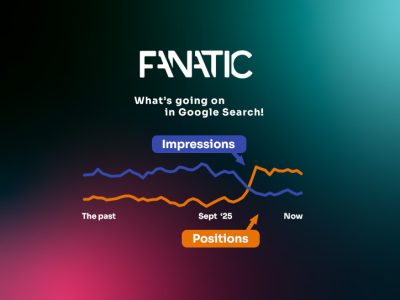September 29, 2025
If you have recently seen a sharp drop in impressions in Google Search Console, please don’t be alarmed. This isn’t a penalty, your SEO efforts are still working, and your website traffic remains steady. Here’s what has changed and why your reports may look different.


If you’re an SEO specialist checking Google Search Console performance regularly, or you’re one of our clients keeping a close eye on the Looker Studio reports we’ve crafted for you, you definitely would’ve noticed something alarming around mid-September: overnight, your website seemingly lost about 50% of its visibility whilst magically improving average keyword positions by a page or two.
You’re not alone, and this didn’t happen just to your website – this happened to virtually every website on Google Search. And as always, when you see something initially unexplainable in the SEO world, it’s usually Google changing something they consider “minor” (but which sends us all into a mild panic).
In this case, Google quietly removed a search results parameter (&num=100) that had been working behind the scenes for years.
That small piece of code allowed crawlers and SEO tools to see the top 100 results at once, instead of working through the results page by page. Without it, tools such as Semrush, Ahrefs and SE Ranking can no longer collect as much data from deeper in the search results.
Fewer results being tracked meant fewer [bot] impressions being recorded in your Search Console data. The maths is really that simple.
Now this explains the drop in impressions, but what about those mysteriously improved keyword positions?
I always tell our clients and junior SEO specialists that Google and its algorithms are built for us – humans, not bots or crawlers. When a page gets impressions but doesn’t attract clicks in good proportions, Google’s algorithm interprets this as a signal that users aren’t finding the page compelling enough to click through.
What we now realise is that all those bot-generated impressions from SEO tools were artificially inflating your impression counts whilst simultaneously making your click-through rates appear worse than they actually were. Google’s algorithm was essentially being fed false data about user behaviour, which may have been holding back your true ranking potential.
With this change, Google has inadvertently given us a clearer picture of genuine human behaviour rather than machine-generated noise. Your improved average positions likely reflect where your pages truly deserve to rank based on real user engagement.
The SEO tools industry is now trying to adapt their systems. Instead of one request for 100 results, they now need to make 10 separate requests – a tenfold increase in server load and costs. This will likely mean subscription price increases across the board as tool providers pass these costs on.
As these adaptations roll out over the coming months, we might see some fluctuations in our Semrush reports. However, the Google Search Console data should now provide a more accurate reflection of genuine user behaviour.
While this change initially caused some concern, it’s actually improved the quality and accuracy of our performance data. For the first time in ages, I feel like we can trust the impressions and position data we’re seeing as they now reflect real human behaviour rather than bot activity.
So take heart – those “improved” average positions and more realistic impression counts are likely showing you the SEO performance we’ve actually earned all along.
For our clients
As your SEO team, we’re monitoring how this evolves and will ensure our monthly reporting calls continue to provide the meaningful insights you rely on. If anything, this change means we’ll be working with cleaner, more accurate data – which can only be a good thing for our strategy.
Not working with us yet?
If you’ve been scratching your head over recent changes in your Google Search Console data, get in touch and let’s have a proper conversation about what’s really happening with your organic search performance.